| Pages:
1
2
3 |
AJKOER
Radically Dubious
    
Posts: 3026
Registered: 7-5-2011
Member Is Offline
Mood: No Mood
|
|
Panache:
You can stop making comments supporting my postulated electrochemistry (a new thread/pictures/results soon available exploring a related, but I
suspect inferior to the ammonia cell, which I proposed above is likely one of the better path).
Anodic corrosion apparently works more efficiently when the relative surface area of the metal anode, here Tungsten, in my proposed ammonia/H2O2 or O2
electrochemical cell scheme is small. To repeat, when the relative electrode surface area ratio is SMALL (hence low surface area metal Tungsten), say,
to the solution's surface area contact with air, the anodic corrosion accelerates.
The cell may create an electric current and associated solvated electrons, e-(aq), so with preferentially added NH4Cl or the sulfate via:
NH4+ = H+ + NH3
And, the removal of H+:
e-(aq) + H+ = .H
the latter two reactions occurring in solution could supply added NH3 (and I would further guess that starting with the highest ammonia concentration
is likely not optimal and having the right NH4+ concentration is a factor, see https://www.sciencedirect.com/science/article/abs/pii/S03043... which discusses optimal leaching factors).
[Edited on 25-8-2019 by AJKOER]
|
|
|
stamasd
Hazard to Others
  
Posts: 133
Registered: 24-5-2018
Location: in the crosshairs
Member Is Offline
Mood: moody
|
|
Quick update on this after a couple of months.
I had originally set up an experiment with a 2g fragment of tungsten, plus H2O2 (27%) and NH4OH (30%). Then I forgot about it.
I found that beaker again last week. All liquid had evaporated (must have been 20ml or so) and the tungsten rod, which initially had showed just a
little mass loss, had completely disappeared. What was left was a yellow mass at the bottom, which I thought at first to be crystalline. At closer
examination they aren't crystals but irregular pieces that appear like dried-out and broken jello. They are translucent, and I assume they are a mix
of ammonium paratungstate (which is white) and tungsten trioxide and/or tungstic acid (which are bright yellow).
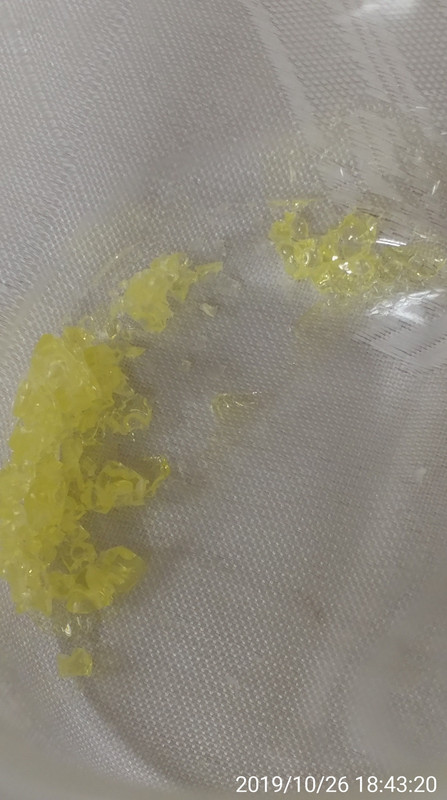
I haven't worked that up yet. I'm surprised how well it worked to dissolve all of the tungsten.
But in the meantime I set another experiment up, larger scale. In 2 flasks I added 20g of tungsten pieces each, followed by 25ml of 27% H2O2 each, and
in one of them also 5ml of 30% NH4OH. Initially the flask with ammonia heated up a lot and started boiling, almost boiling over despite being a fairly
large (500ml) flask. The color of the liquid changed to pale yellow. The other flask with only H2O2 only showed very little gas bubble formation at
the surface of the tungsten, which ceased by the next day.
Next morning the yellow color in the ammonia flask had faded, both flasks had a very slightly yellow solution.
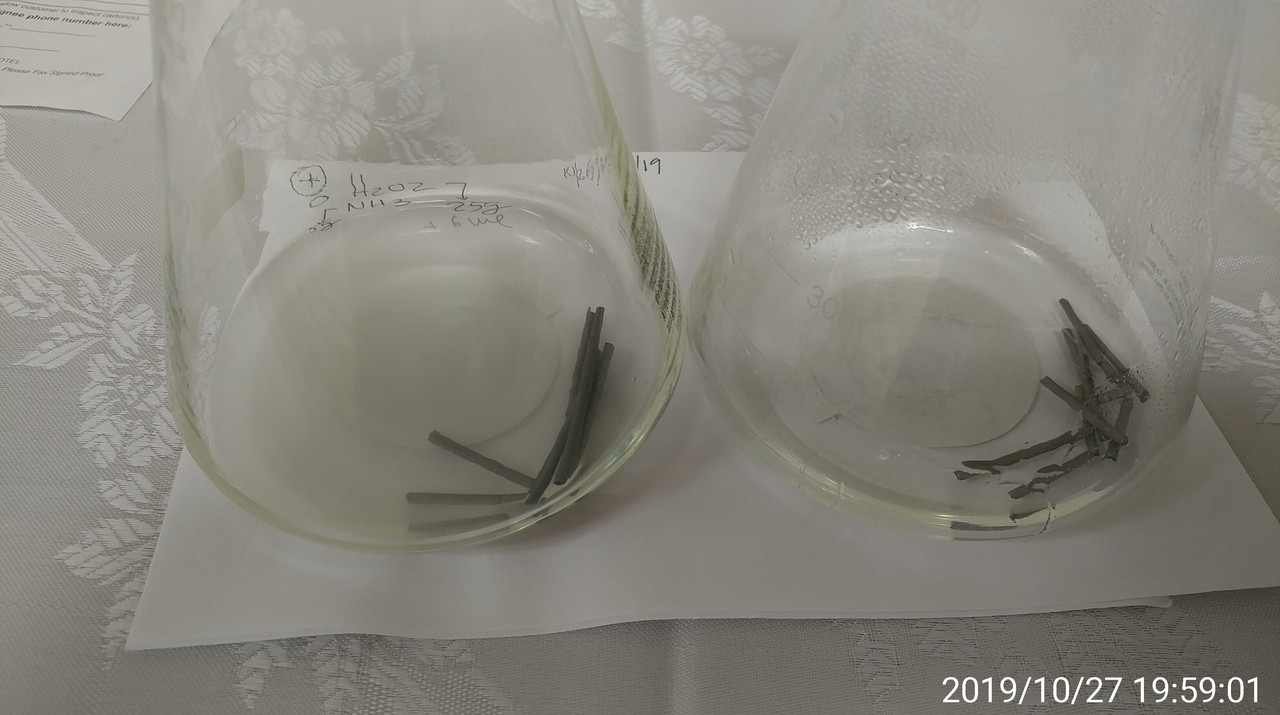
Left with ammonia, right without.
I added 6ml H2O2 to each, and in the flask with ammonia the yellow color suddenly intensified. No color change in the one without ammonia. Also no gas
bubble formation in either.
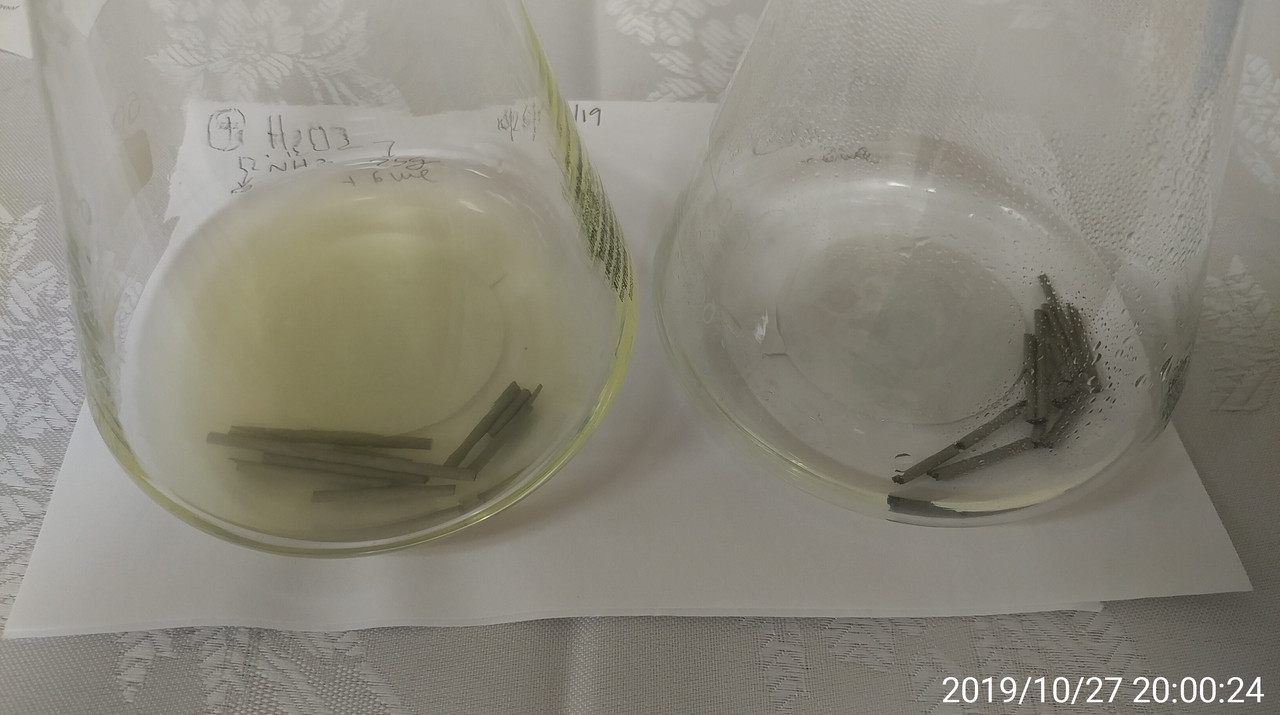
I kept the same pattern daily; each day adding 6ml H2O2 in each flask, and every other day 1ml of NH4OH to the left flask only (I keep that one
covered with parafilm to minimize ammonia loss). The same phenomenon kept occurring, loss of color by the next day and color intensifies in the left
flask as soon as more H2O2 is added. The color in the right flask doesn't change upon addition, just slowly becomes more yellow from day to day.
Flasks on the 3rd day before and after additions:
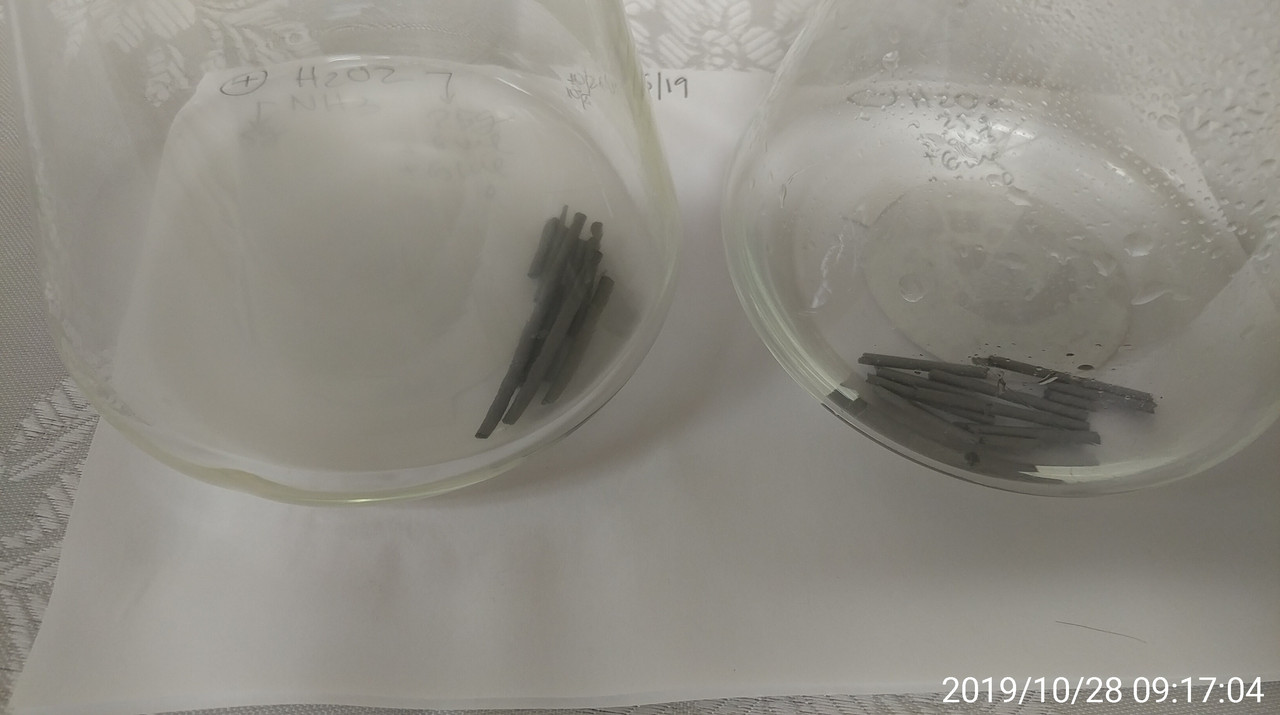
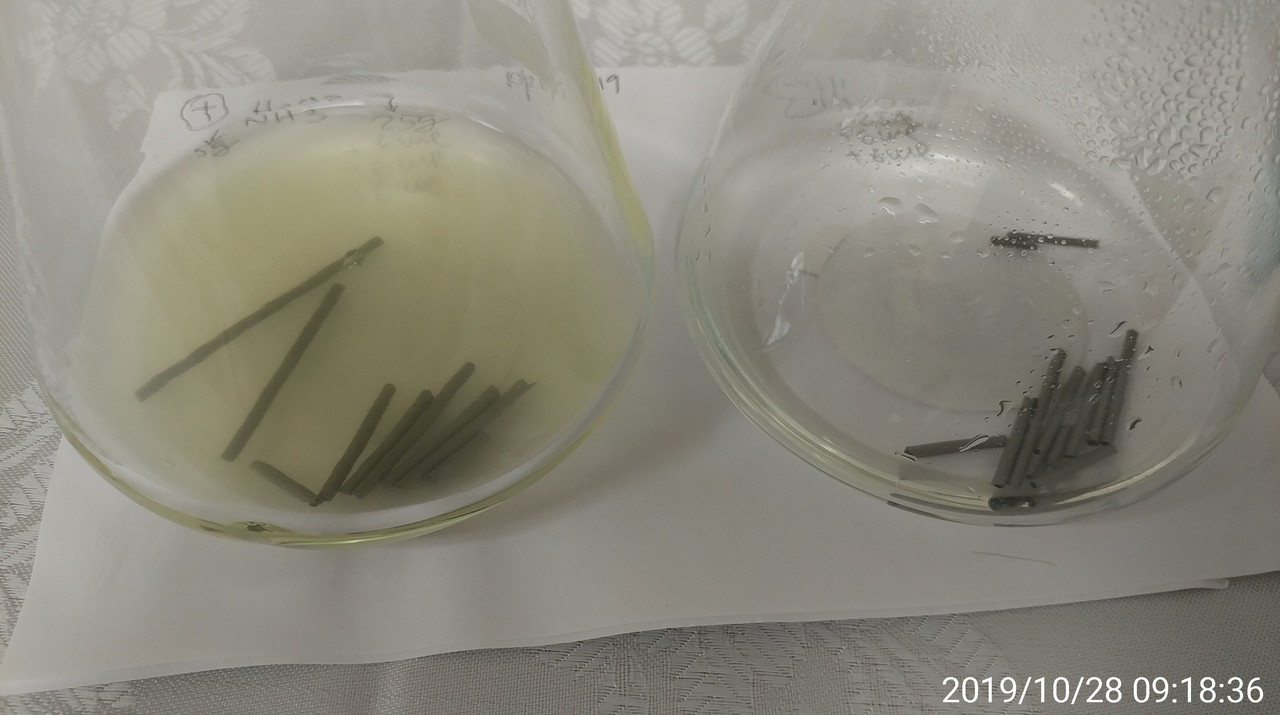
I noticed that in the left flask (with ammonia) a very fine, dust-like, off-white precipitate has started to form. The precipitate does not change
color when I add more H2O2.
No pics on day 4. Here are pics from today, which is day 5. The color changes have become a lot more intense, and there is a lot more of the
precipitate.
Before:
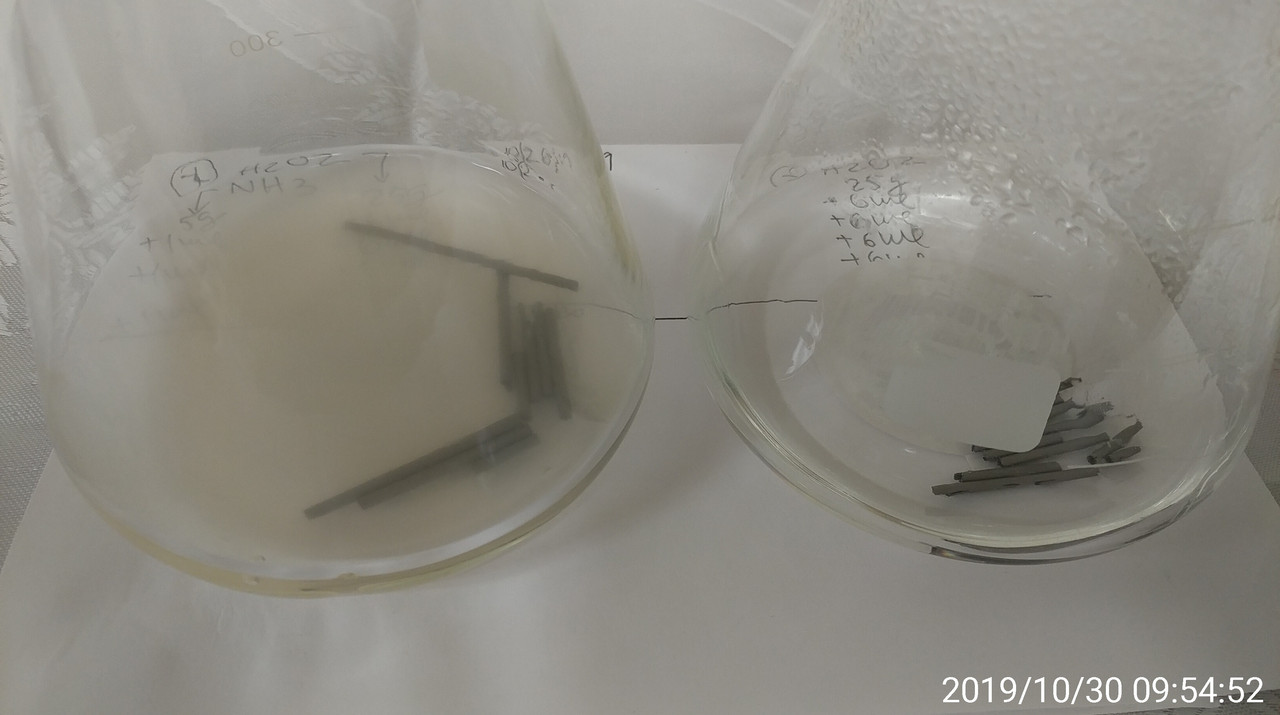

And after H2O2:

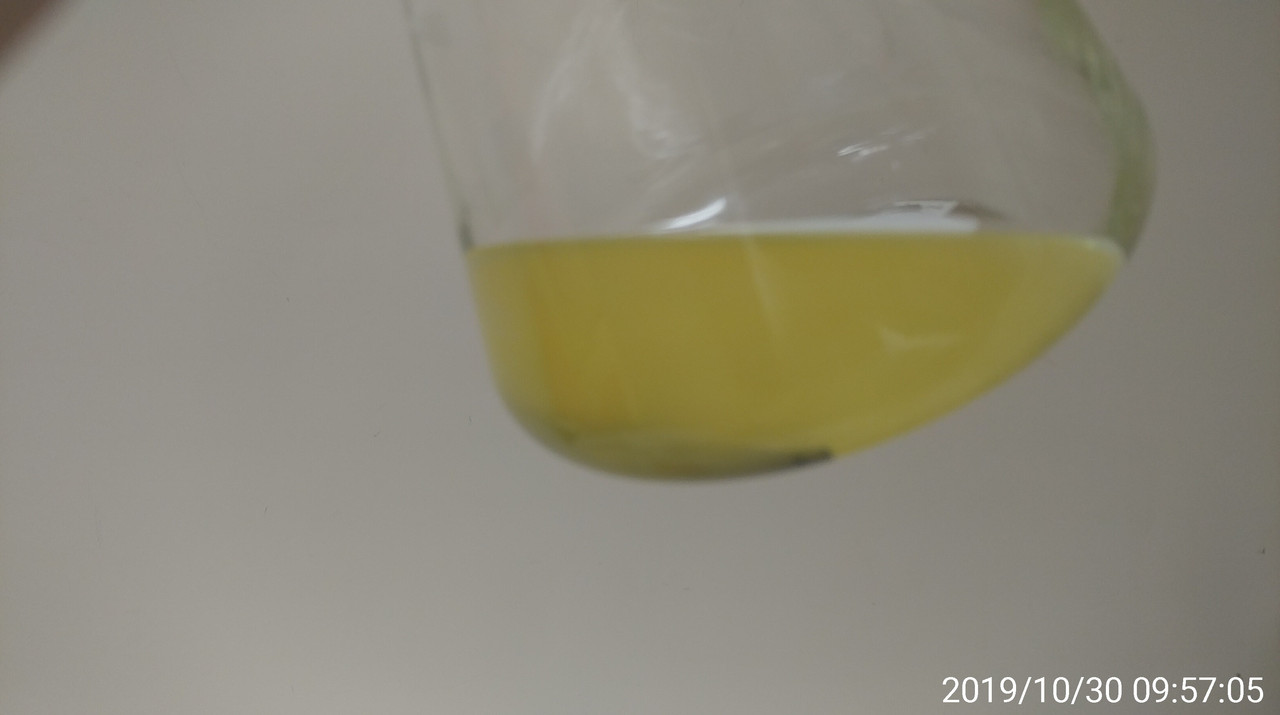
So far each flask has received 55ml of 27% H2O2, and the left flask only got a total of 8ml 30% NH4OH.
I will keep adding reagents in the same pattern for another 5 days then will just observe.
[Edited on 30-10-2019 by stamasd]
|
|
|
stamasd
Hazard to Others
  
Posts: 133
Registered: 24-5-2018
Location: in the crosshairs
Member Is Offline
Mood: moody
|
|
Pics from this morning.
Before:

Added ammonia (1ml) in the left flask only; no color change.
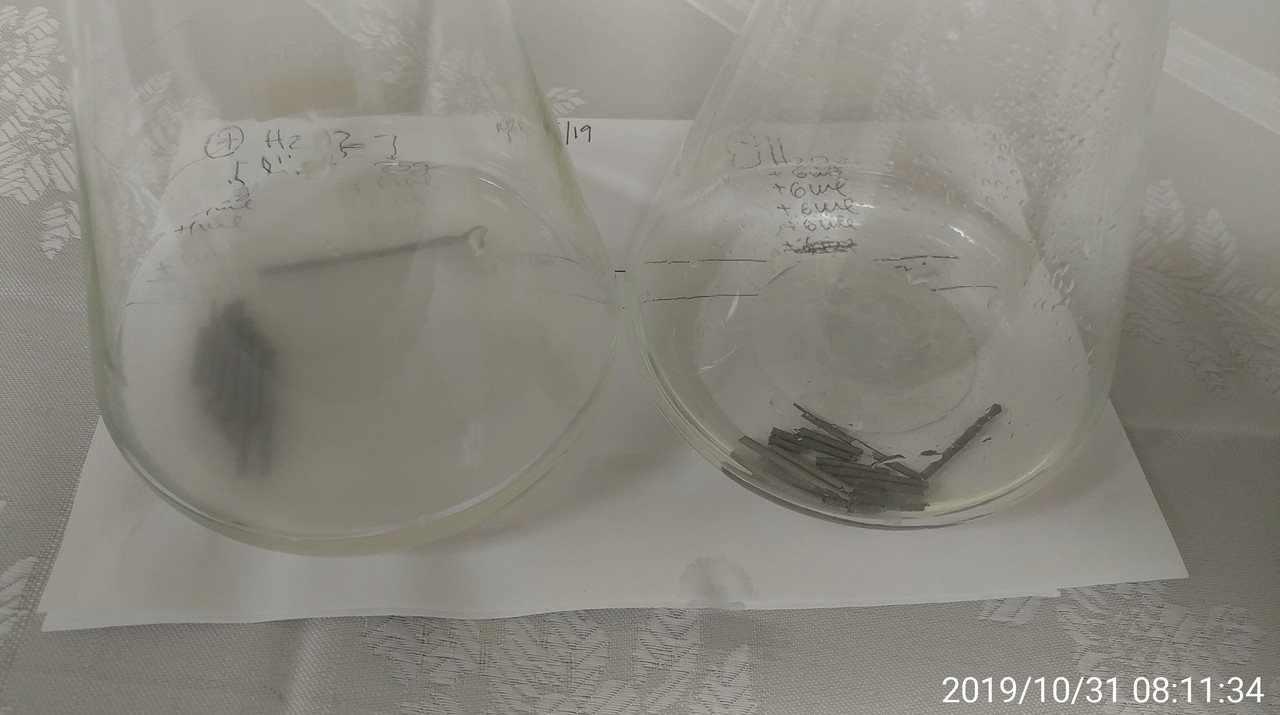
Added H2O2 (6ml) to both; yellow color reappears in the left flask.

|
|
|
Herr Haber
International Hazard
    
Posts: 1236
Registered: 29-1-2016
Member Is Offline
Mood: No Mood
|
|
Hello stamasd !
I have tungsten in almost every possible form except plate / foil.
I have all the reagents you used in your experiments and more.
Most important: I have a little bit of space
So if there's an experiment you are not doing for lack of space, time or reagents let me know.
The spirit of adventure was upon me. Having nitric acid and copper, I had only to learn what the words 'act upon' meant. - Ira Remsen
|
|
|
stamasd
Hazard to Others
  
Posts: 133
Registered: 24-5-2018
Location: in the crosshairs
Member Is Offline
Mood: moody
|
|
I have space and reagents, time however is another matter... I happen to have some time right now though. Thanks for the offer!
The next thing I plan to try is to see if I can speed up the tungsten dissolution using electrochemistry. But that won't be until this experiment is
over.
|
|
|
wg48temp9
National Hazard
   
Posts: 761
Registered: 30-12-2018
Location: not so United Kingdom
Member Is Offline
|
|
Molybdenum can also be dissolved with H2O2. If the Mo is in excess when the H2O2 has all reacted to form Mo acid the Mo metal then reduces the acid
to a Mo blue.
See the image below from a thread titled "blue tungstic or Molybdic acid ?"
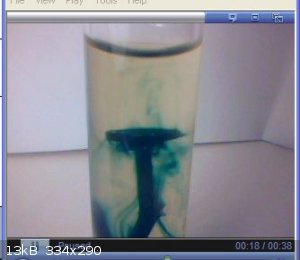
I am wg48 but not on my usual pc hence the temp handle.
Thank goodness for Fleming and the fungi.
Old codger' lives matters, wear a mask and help save them.
Be aware of demagoguery, keep your frontal lobes fully engaged.
I don't know who invented mRNA vaccines but they should get a fancy medal and I hope they made a shed load of money from it.
|
|
|
stamasd
Hazard to Others
  
Posts: 133
Registered: 24-5-2018
Location: in the crosshairs
Member Is Offline
Mood: moody
|
|
Hmm. No pics today, but...
I spent a little time looking at the 2 flasks and I noticed something interesting, which I had not observed until today.
The second flask, the one with only H2O2 and no ammonia, which does not exhibit any color changes when I add more reagent to it, may be in fact more
interesting than the other one.
What I noticed is that in that second flask there is now definitely less metallic tungsten remaining compared to the other one. They both started with
the same amount (20g) of fragments from 2mm tungsten rods.
Well, the rods in flask 2 are now significantly thinner than the ones in flask 1. I'd say they're no more than 1mm in diameter. 
If I'm right, they should completely dissolve in the next 3-4 days.
We'll see.
[Edited on 2-11-2019 by stamasd]
|
|
|
stamasd
Hazard to Others
  
Posts: 133
Registered: 24-5-2018
Location: in the crosshairs
Member Is Offline
Mood: moody
|
|
Okay update with some very interesting information and some calculations.
I pulled out all of the remaining metallic tungsten in both flasks and dried it separately. I was right, the pieces in the H2O2 alone are much thinner
and lighter. Here are some photos for comparison.
Left, H2O2+NH4OH; right, H2O2 alone.
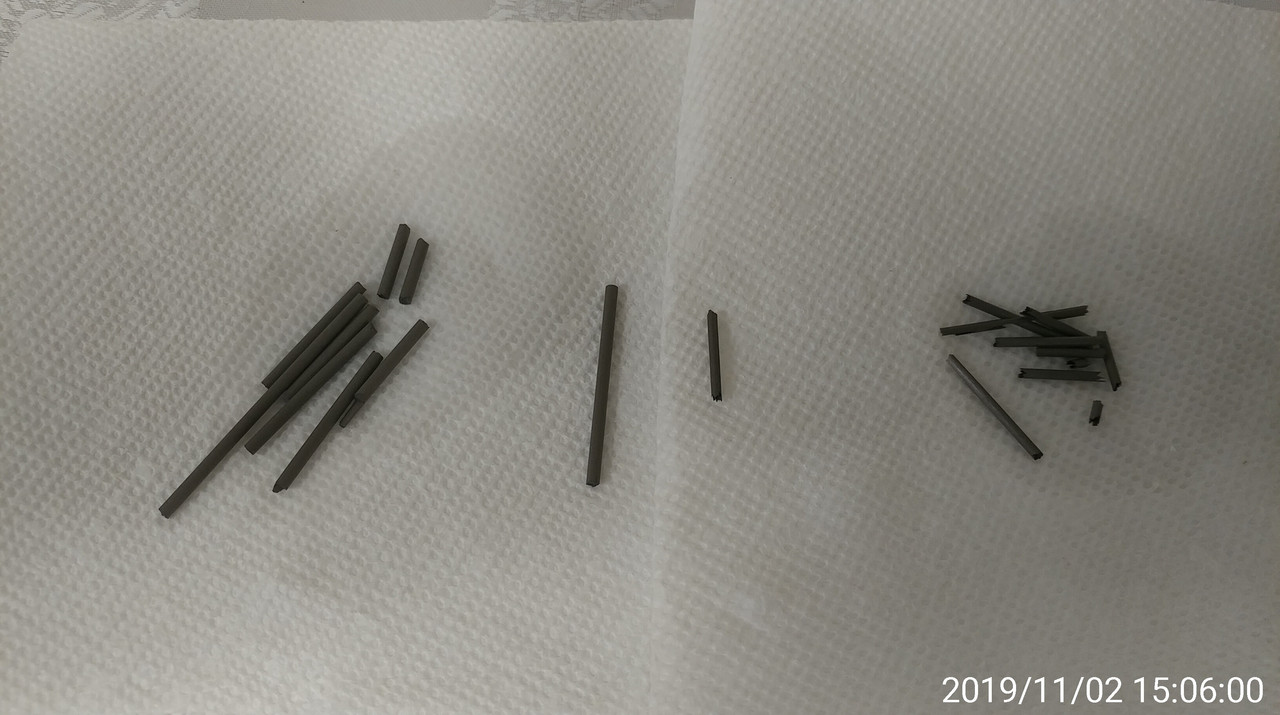
Same but closer look.
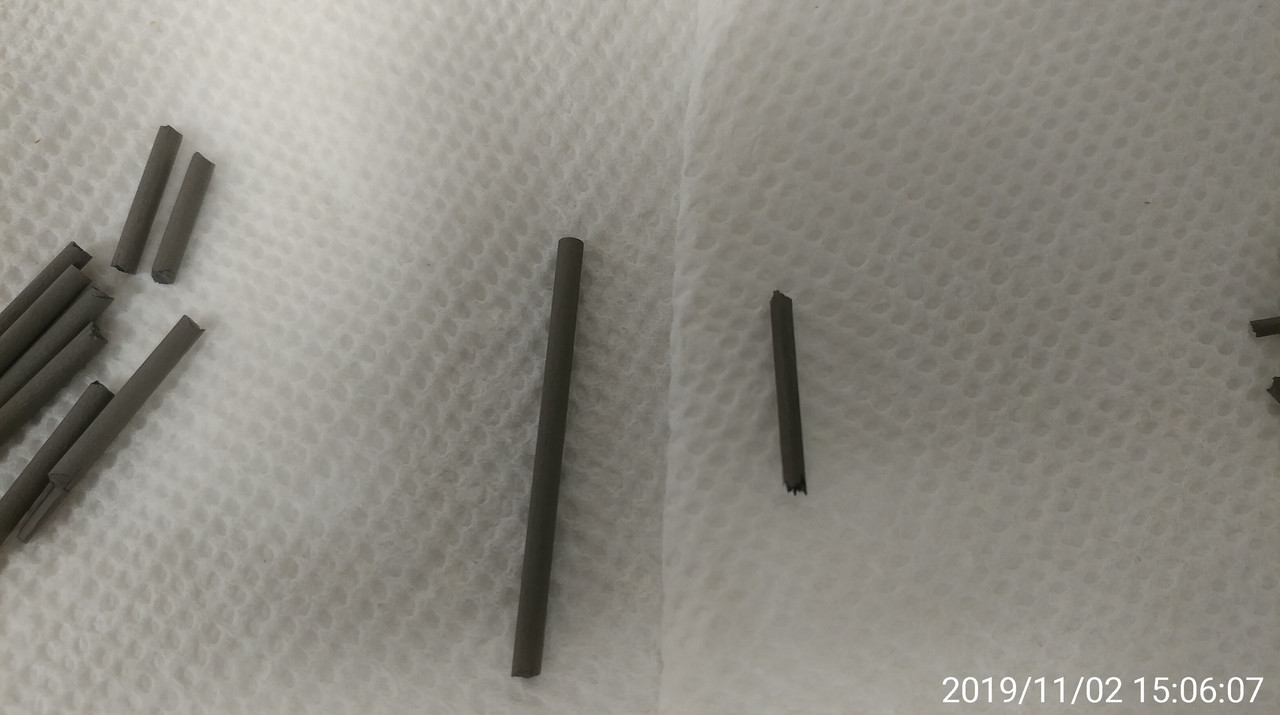
I then weighed the metal separately. The initial weight was 20.0g for both samples.
The metal from H2O2+NH4OH:
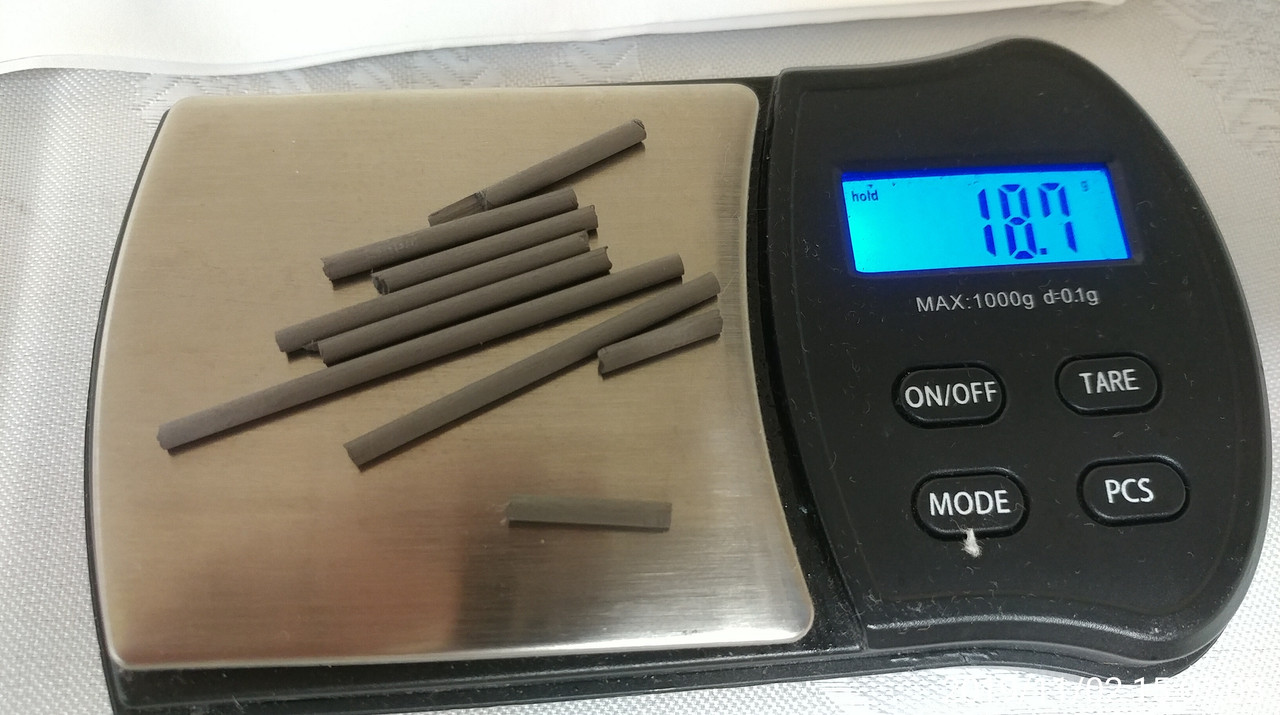
The metal from H2O2 alone:
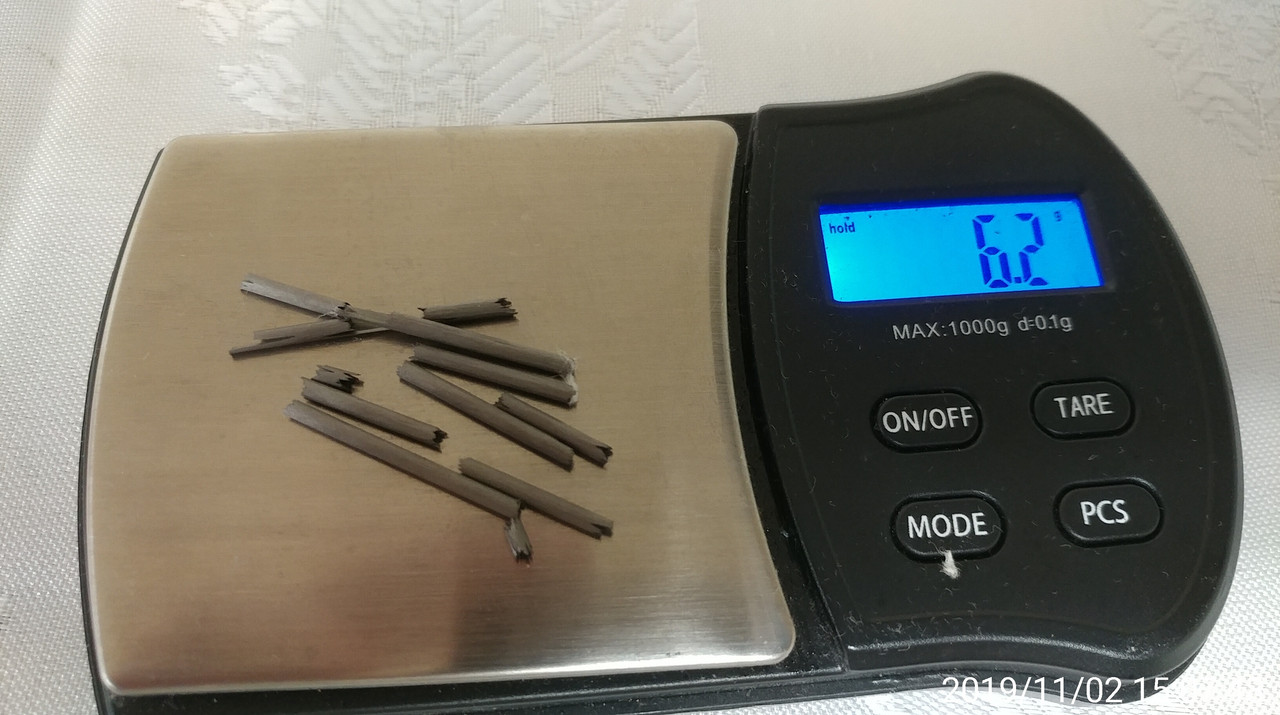
So in 8 days, the H2O2+NH4OH dissolved 1.3g, whereas the H2O2 alone dissolved 13.8g. Or 0.1625g/day and 1.725g/day respectively.
The NH4OH is actually detrimental to the rate of reaction, slowing it down more than 10x.
|
|
|
fusso
International Hazard
    
Posts: 1922
Registered: 23-6-2017
Location: 4 ∥ universes ahead of you
Member Is Offline
|
|
I wonder if you only add a little NH3 after considerable amount of W is oxidsed, to dissolve most of the oxides, will the dissolved tungstates affect
the rate?
Also how does aq NH3 slow down the rxn? Is it due to the extra water or NH3/tungstates decomposing the H2O2?
|
|
|
stamasd
Hazard to Others
  
Posts: 133
Registered: 24-5-2018
Location: in the crosshairs
Member Is Offline
Mood: moody
|
|
I don't have an explanation, these are just my observations. If I were to guess, I'd venture to say that the rate of decomposition of the H2O2 is
probably higher in the presence of ammonia. Also apparently no ammonia is needed to dissolve the oxidation product as the solution in the flask with
only H2O2 is perfectly clear, if only slightly yellowish but with no visible precipitates.
[Edited on 2-11-2019 by stamasd]
|
|
|
wg48temp9
National Hazard
   
Posts: 761
Registered: 30-12-2018
Location: not so United Kingdom
Member Is Offline
|
|
H2O2 is oxidising in acid but in alkali it can be reducing. So I guess if you put too much ammonia in the H2O2 will not oxidize the W or the
oxidation rate will be reduced.
I am wg48 but not on my usual pc hence the temp handle.
Thank goodness for Fleming and the fungi.
Old codger' lives matters, wear a mask and help save them.
Be aware of demagoguery, keep your frontal lobes fully engaged.
I don't know who invented mRNA vaccines but they should get a fancy medal and I hope they made a shed load of money from it.
|
|
|
Tsjerk
International Hazard
    
Posts: 3022
Registered: 20-4-2005
Location: Netherlands
Member Is Offline
Mood: Mood
|
|
How would hydrogen peroxide be reducing? I can only imagine it being oxidized by something like fluorine or chlorine trifluoride.
|
|
|
stamasd
Hazard to Others
  
Posts: 133
Registered: 24-5-2018
Location: in the crosshairs
Member Is Offline
Mood: moody
|
|
2 KMnO4 + 3 H2O2 --> 2 MnO2 + 2 KOH + 2 H2O + 3 O2
Mn(VII) is reduced to Mn (IV) by the oxygen in H2O2, which itself is oxidized to O2.
[Edited on 3-11-2019 by stamasd]
|
|
|
Mesa
Hazard to Others
  
Posts: 264
Registered: 2-7-2013
Member Is Offline
Mood: No Mood
|
|
Fastest/easiest way to dissolve W... Make a thermite-like rxn with NaOH or KOH and dissolve the resulting ash in H2O2.
Alternatively, if you can get it as a powder, ignite a pile of it in open air with a lighter flame, and spread the pile around while it slowly turns
red hot, then cools to a fluffy-er yellow WO3 powder.
Reaction is self sustaining with any fine grit W or carbide powder.
Note: if carbide is used, you might have to separate any trace cobalt or molybdenum compounds. Not quite sure though. I only saw it happen in
workplace fuckups at my old job. Never tried igniting WC intentionally myself
|
|
|
stamasd
Hazard to Others
  
Posts: 133
Registered: 24-5-2018
Location: in the crosshairs
Member Is Offline
Mood: moody
|
|
I don't have a cheap source of powdered W or WC. My W is in the form of broken 2mm rods. I'd also prefer if the resulting WO3 is not contaminated with
other chemicals if possible.
Also, as someone else says, I like to explore the science of it. I haven't seen the color change yellow/colorless/yellow mentioned anywhere else, nor
the kinetics of W dissolution in acidic vs alkaline conditions.
|
|
|
Mesa
Hazard to Others
  
Posts: 264
Registered: 2-7-2013
Member Is Offline
Mood: No Mood
|
|
You could probably just dissolve the ash in conc. NaOH to get sodium tungstate and whatever Na products formed, then treat with HCl to precipitate
WO3, all Na products remain soluable.
Without trying it myself I'm not so sure it would dissolve. I'm pretty confident that the HCl step would effectively isolate WO3 product though. No
other products could form from the thermite form from HCl except NaCl and H2WO4(decomposes to WO3 in H2O) right?
[Edited on 8-11-2019 by Mesa]
EDIT: There's a pretty easy method to purify any soluable tungsten compound.
Make the ammonium tungstate from HCl + tungstate, separate crystals and redissolve in ammonia solution, evaporate, then fire in open crucible til
ammonia stops evolving.
This should work to purify the WO3 you've produced also. In case there is any impurities from electrodes.
I'll post patents when I get on home computer.
[Edited on 9-11-2019 by Mesa]
|
|
|
stamasd
Hazard to Others
  
Posts: 133
Registered: 24-5-2018
Location: in the crosshairs
Member Is Offline
Mood: moody
|
|
But then I wouldn't be investigating which compound I get from dissolving tungsten in plain H2O2, as I plan on doing soon. You'd think it would be
either WO3 and/or H2WO4, but these are bright yellow and completely insoluble. Whereas what I got is a perfectly clear solution that is almost
colorless, only a very pale yellow. And that despite having almost 20g dissolved tungsten per 100ml. Whatever is the tungsten species I have (and I'm
open to suggestions as to what it is) it's highly soluble.
|
|
|
Mesa
Hazard to Others
  
Posts: 264
Registered: 2-7-2013
Member Is Offline
Mood: No Mood
|
|
The solution will precipitate out WO3 over time. I'm not sure what the dissolved species is, except that its unstable in solution and eventually
degrades to insoluble WO3 if left alone.
|
|
|
stamasd
Hazard to Others
  
Posts: 133
Registered: 24-5-2018
Location: in the crosshairs
Member Is Offline
Mood: moody
|
|
Actually I'm not so sure about that. I haven't touched the flasks for 4 days and their appearance is unchanged as far as the liquid is concerned, only
the little bit of tungsten left still undissolved is getting progressively smaller. The liquid is still perfectly clear and very slightly yellow. In a
few places it has splashed on the walls and the drops evaporated leaving behind a white deposit with no yellow tinge at all.
[Edited on 15-11-2019 by stamasd]
|
|
|
Mesa
Hazard to Others
  
Posts: 264
Registered: 2-7-2013
Member Is Offline
Mood: No Mood
|
|
Try adding a few drops of HCl.
|
|
|
stamasd
Hazard to Others
  
Posts: 133
Registered: 24-5-2018
Location: in the crosshairs
Member Is Offline
Mood: moody
|
|
I'll do that in a small sample when all the tungsten is dissolved. The rate of dissolution has slowed down considerably but there is less than half a
gram left so it shouldn't take more than a few days.
|
|
|
stamasd
Hazard to Others
  
Posts: 133
Registered: 24-5-2018
Location: in the crosshairs
Member Is Offline
Mood: moody
|
|
Only 2 small pieces of tungsten remain, about 0.5mm thick and 3-4mm long each.

|
|
|
Mesa
Hazard to Others
  
Posts: 264
Registered: 2-7-2013
Member Is Offline
Mood: No Mood
|
|
Likely some kind of peroxo tungstic acid such as described in this link
Evaporating the water at no more than 100*c will isolate the pertungstic acid. Heating above 100*c will decompose it to WO3.
Could explain the precipitate on the side of the flasks?
EDIT: This link seems to be more relevant
https://www.researchgate.net/post/How_can_I_get_a_clear_solu...
[Edited on 22-11-2019 by Mesa]
|
|
|
stamasd
Hazard to Others
  
Posts: 133
Registered: 24-5-2018
Location: in the crosshairs
Member Is Offline
Mood: moody
|
|
I can't use the first link "you have reached a page that's unavailable for viewing"
As for the second link, it describes the second part of the experiment (the left flask in some of the pictures above) with H2O2+ammonia, which showed
a dissolution rate 10x slower than plain H2O2.
But yes, it's probable that what I'm getting is an adduct between WO3 and H2O2 aka peroxopolytungstic acid.
[Edited on 22-11-2019 by stamasd]
|
|
|
stamasd
Hazard to Others
  
Posts: 133
Registered: 24-5-2018
Location: in the crosshairs
Member Is Offline
Mood: moody
|
|

The tungsten dissolution is complete. I have set the solution to evaporate.
|
|
|
| Pages:
1
2
3 |